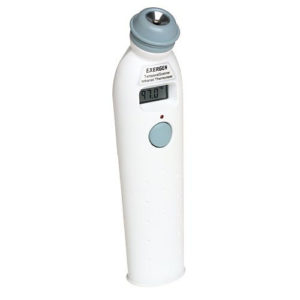Doctors’ Notes
BackThermometers & Temperature Taking
Accurate, reliable temperature readings are important for all children at all ages, but most especially for infants.
A fever — which we define as Core Body Temperature greater than 100.5 — is a SERIOUS issue for infants less than 2 months old. A fever in these kids necessitates a medical evaluation and typically requires an ER visit, which usually leads to a 48-hour stay in the hospital for observation and antibiotics. (This is called an R/O Sepsis Evaluation.)
 The use of a digital stick thermometer placed under the arm provides a rough estimate — typically within 1 degree Farenheit of Core Body Temperature. The results of this method are variable and should not be used for accurate attempts to measure childrens’ temperatures.
The use of a digital stick thermometer placed under the arm provides a rough estimate — typically within 1 degree Farenheit of Core Body Temperature. The results of this method are variable and should not be used for accurate attempts to measure childrens’ temperatures.
The Standard of Care for measuring infant (less than 2 months old) temperature is a rectal (in the bottom) temperature with a digital stick thermometer. At Kids Plus, we suggest using this method for all children younger than 1 year old, because it provides the most accurate, reliable reading.
Glass models with mercury inside, long the standard design for thermometers, are no longer manufactured — and should not be used — due to both safety and environmental issues.
Binky/Pacifer thermometers and Forehead Strip thermometers are not recommended by Kids Plus, due to lack of accuracy and reliability from previous tests and reports.
Newer methods of temperature-taking with infared technology initially produced ear thermometers, but in the past few years more and more doctors and parents are switching to Temporal Scanner thermometers for improved convenience and accuracy. Ear thermometers can give quick results, but their accuracy depends on correct placement in your child’s ear, as well as no impediments (like built-up earwax) to the reading.
The two highest-rated Temporal Scanner forehead thermometers in a recent Consumer Reports survey were the Vicks V977 and the Exergen Temporal Scanner TAT-2000C. We’ve been using Exergen models in our Kids Plus Offices, and we’ve been pleased with both their convenience and their accuracy.
For more information about temperature-taking, including instructions on how best to take a rectal temperature, see this resource page from the American Academy of Pediatrics. For more information about fever, see Dr. Maddalena’s excellent Doctor’s Note on the subject.
And, as always, call our offices any time you have questions or concerns.
Dr. Wolynn is President & CEO of Kids Plus Pediatrics.